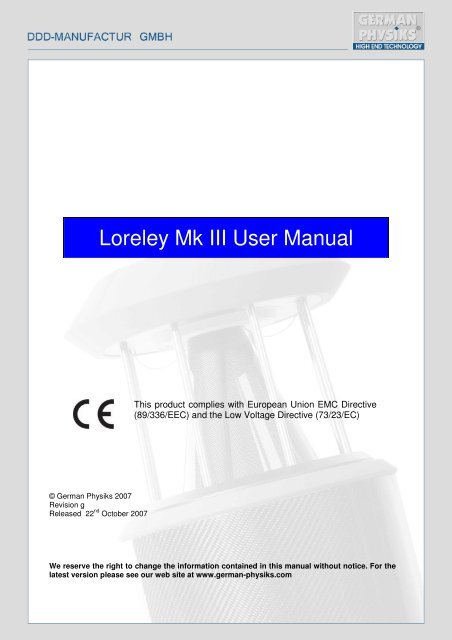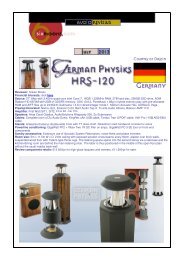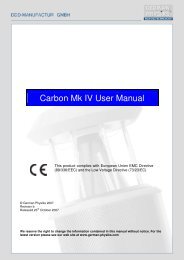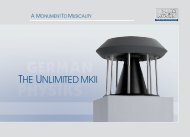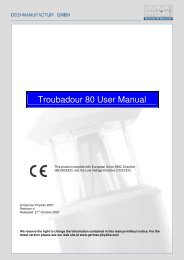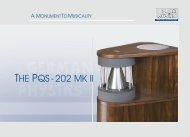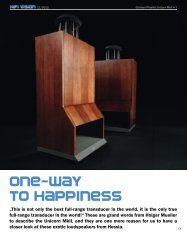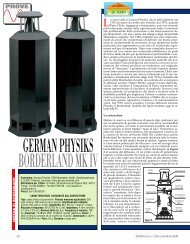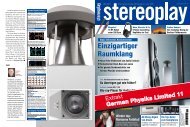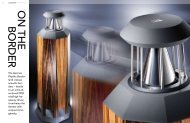Loreley Mk III User Manual - German Physiks
Loreley Mk III User Manual - German Physiks
Loreley Mk III User Manual - German Physiks
You also want an ePaper? Increase the reach of your titles
YUMPU automatically turns print PDFs into web optimized ePapers that Google loves.
<strong>Loreley</strong> <strong>Mk</strong> <strong>III</strong> <strong>User</strong> <strong>Manual</strong><br />
This product complies with European Union EMC Directive<br />
(89/336/EEC) and the Low Voltage Directive (73/23/EC)<br />
© <strong>German</strong> <strong>Physiks</strong> 2007<br />
Revision g<br />
Released 22 nd October 2007<br />
We reserve the right to change the information contained in this manual without notice. For the<br />
latest version please see our web site at www.german-physiks.com
TABLE OF CONTENTS<br />
1. INTRODUCTION............................................................................................................................ 3<br />
2. UNPACKING YOUR LOUDSPEAKERS ....................................................................................... 3<br />
3. ASSEMBLING YOUR LOUD SPEAKERS .................................................................................... 5<br />
Introduction ............................................................................................................................... 5<br />
Assembly Procedure................................................................................................................. 6<br />
4. CONNECTING YOUR LOUDSPEAKERS .................................................................................... 10<br />
High Frequency Level Control .................................................................................................. 10<br />
Low Frequency Level Control ................................................................................................... 10<br />
Input Terminal Connections ...................................................................................................... 11<br />
Single Wire Connection ....................................................................................................... 11<br />
Bi- Wire Connection............................................................................................................. 11<br />
Bi- Amp Connection............................................................................................................. 11<br />
5. LOUDSPEAKER BREAK IN.......................................................................................................... 11<br />
6. LOUDSPEAKER PLACEMENT AND SET-UP ............................................................................. 12<br />
Listening Room Layout ............................................................................................................. 12<br />
Loudspeaker Placement ........................................................................................................... 12<br />
Distance from rear wall: ....................................................................................................... 12<br />
Distance from side wall:....................................................................................................... 12<br />
7. CARE OF YOUR LOUDSPEAKERS............................................................................................. 14<br />
8. WARRANTY .................................................................................................................................. 14<br />
9. SERVICE AND SUPPORT............................................................................................................ 14<br />
10. HOW TO CONTACT US .............................................................................................................. 15<br />
11. LORELEY <strong>Mk</strong>II SPECIFICATIONS .............................................................................................. 16<br />
12. WARRANTY REGISTRATION..................................................................................................... 17<br />
2
1. INTRODUCTION<br />
Thank you for selecting the <strong>German</strong> <strong>Physiks</strong> <strong>Loreley</strong> for your audio system. It uses an array of four<br />
DDD drivers to cover all frequencies above 180Hz. The low frequencies are handled by a system using<br />
two 12 inch drivers combined with four 8 inch passive radiators. The <strong>Loreley</strong> is entirely handmade and is<br />
built and tested by highly skilled technicians at our factory in <strong>German</strong>y.<br />
Every step in the design and manufacture of this product has been dedicated to producing a loudspeaker<br />
that will provide a lifetime of musical enjoyment.<br />
We strongly recommend that you read this manual before you attempt to use the loudspeakers. The<br />
supplying audio dealer is responsible for assembling and setting up the loudspeakers. This should not<br />
be attempted by the customer. Information on these topics contained in this manual is intended for<br />
general use only.<br />
2. UNPACKING YOUR LOUDSPEAKERS<br />
NOTE:<br />
The customer should not attempt to assemble the loudspeaker.<br />
This will be done by the supplying audio dealer.<br />
The crates and their contents are heavy. To avoid injury, please<br />
ensure that 2 people are available to unpack and position the<br />
loudspeakers.<br />
The <strong>Loreley</strong> is supplied in 3 crates. Before opening them, please inspect them for damage. If you see<br />
any damage to the crates, please contact the supplying audio dealer immediately and provide them with<br />
a full description of the damage. Do not attempt to unpack the loudspeakers until you have spoken with<br />
the dealer and have been advised how to proceed.<br />
The woofer module assemblies for the left and right channels are packed in separate crates which are<br />
marked “left” and “right” on the outside. Take care not to mix components from these two crates up. The<br />
two DDD towers are packed together in the third crate.<br />
Please retain all of the packing as you will need this should it be necessary in the future to ship the<br />
loudspeakers. Should you need to return the loudspeakers to the factory, you must use the original<br />
packing. The use of any other packing may result in the loudspeakers sustaining damage in transit.<br />
Such damage is not covered by the warranty. Should you require replacement packing, please contact<br />
your <strong>German</strong> <strong>Physiks</strong> dealer, the national distributor or the factory directly.<br />
The crates and their contents are heavy. To avoid injury, please ensure that 2 people are available to<br />
unpack and position the loudspeakers. Use Figure 1 to identify the major components and confirm that<br />
the crates contain the following items:<br />
Item Quantity Description<br />
1 2 Bottom Plates<br />
2 2 Lower Modules<br />
3 2 Distance Frames<br />
4 2 Upper Modules<br />
5 2 Top Plates<br />
6 2 DDD towers<br />
7 24 Inter-Cabinet Connecting Cables<br />
8 1 <strong>User</strong> manual<br />
9 4 Cleaning cloths<br />
If any items are missing, or if any item shows signs of damage, please contact the supplying audio<br />
dealer immediately.<br />
3
5. Top Plate<br />
4. Upper Module<br />
6. DDD Tower 3. Distance Frame<br />
2. Lower Module<br />
1. Bottom Plate<br />
Figure 1. <strong>Loreley</strong> Major Components<br />
4
3. ASSEMBLING YOUR LOUDSPEAKERS<br />
Introduction<br />
Because of the complexity of the <strong>Loreley</strong>, customers are strongly requested not to attempt to assemble<br />
or set up the loudspeakers on their own. These tasks will be carried out by the supplying dealer who has<br />
received detailed training from <strong>German</strong> <strong>Physiks</strong> engineers. Many of the component parts are very heavy<br />
and personal injury could result if they are inappropriately lifted. Component parts could also be<br />
damaged by inexpert handling and any resulting damage would not be covered by the warranty.<br />
The following description of the assembly process is for general information only. It is not intended to be<br />
used as a guide for assembling the loudspeakers, as it has been simplified for the sake for clarity.<br />
Please refer to figure 1 to familiarise yourself with the major components.<br />
We will describe the assembly process for the left loudspeaker. This has its two 12 inch drivers located<br />
on the right side of the woofer modules, as can be seen in figure 2 below.<br />
Left Loudspeaker<br />
Right Loudspeaker<br />
Figure 2. <strong>Loreley</strong> Front View<br />
5
Assembly Procedure<br />
1. Place the left loudspeaker bottom plate on the floor in the position where the speaker is to be sited.<br />
Ensure that it is sitting squarely on all 5 support points and that it is level. Please refer to figure 9 for<br />
guidance.<br />
2. Identify the left lower module. This has<br />
the input terminals and level selectors on<br />
its rear face. This module is very heavy<br />
and you may find it easier to grip if the<br />
woofer grills are removed first. Place it<br />
carefully on top of the bottom plate as<br />
shown in figure 3. Ensure that it is properly<br />
seated.<br />
Figure 3. Lower Module on Bottom Plate<br />
3. Replace any grills that have been<br />
removed and then place the distance frame<br />
on top of the lower module as shown in<br />
figure 4. Ensure that it is properly seated.<br />
Figure 4. Lower Module with Distance Frame<br />
6
Figure 5. Fitting Upper Module and Connection Cables<br />
4. The next operation must be carried out by two people. You will need 8 of the black inter-cabinet<br />
connecting cables ready to hand. Identify the left loudspeaker upper module. Place this on top of the<br />
distance frame and ensure that it is properly seated. One person should stand at the front of the<br />
speaker and with their hands placed as shown in figure 5, carefully tilt the upper module forward over<br />
one edge sufficiently to allow the second person to fit the inter-cabinet connecting cables between the<br />
two modules. The upper module may be tilted forward on either edge. Choose the one that is most<br />
convenient. Take great care to ensure that it cannot slip forward whilst being tilted. The sockets are<br />
colour coded. Please ensure that all the cables are correctly connected.<br />
When all the cables have been fitted, slowly tilt the upper module until it is fully upright, while taking<br />
care that none of the cables become pinched between the upper module and the distance frame. Take<br />
great also that you do not trap any fingers under the module as it is put into position.<br />
7
Figure 6. Top Plate Cable Connection<br />
5. Identify the left loudspeaker top plate and fit one black and one red cable to each pair of sockets as<br />
shown in figure 6.<br />
X<br />
X<br />
X<br />
Figure 7. Top Plate Adjusting Screws<br />
The top plate has 3 screws, marked X in figure 7, which will be used by the dealer to adjust the module<br />
stack for any variation in verticality. The customer should not attempt to adjust these.<br />
8
Z<br />
Y<br />
Y<br />
Figure 8. Fitting the DDD Tower and Top Plate<br />
6. Identify the DDD tower. Note that the top is the end with two sockets located in it. Referring to<br />
figure 8, carefully fit the base of the DDD tower, Y, over the locating disc on the bottom plate and<br />
ensure that it is sitting squarely.<br />
Offer up the top plate and plug the 4 connecting cables into their respective sockets on the top of the<br />
upper module and DDD tower. These sockets are colour coded. Please check that like colours are<br />
connected.<br />
Carefully lower the top plate onto the upper module and DDD tower. Take especial care that the<br />
locating disc on the top plate sits squarely inside the top of the DDD tower and is not simply resting on<br />
the point Z. Also take care the cables do not become pinched as the top plate is lowered onto the<br />
upper module and DDD tower.<br />
9
4. CONNECTING YOUR LOUDSPEAKERS<br />
The <strong>German</strong> <strong>Physiks</strong> <strong>Loreley</strong> is a 2 way loudspeaker with separate input terminals for the low<br />
frequency and high frequency sections of the crossover. These drive the woofers and DDD drivers<br />
respectively and are labelled as such. Provision is also made to allow the output level of the low<br />
frequency and high frequency crossovers to be adjusted.<br />
The input terminals and crossover adjustment points are located on a panel fitted on the back of the<br />
lower woofer cabinet. Figure 9 identifies the features on this panel.<br />
High Frequency<br />
Level Control<br />
Low Frequency<br />
Level Control<br />
Crossover High<br />
Frequency Input for<br />
DDD Driver<br />
Crossover Low<br />
Frequency Input for<br />
Woofer<br />
Figure 9. Input Terminals and High Frequency Level Control<br />
High Frequency Level Control<br />
This adjusts the output from the DDD drivers. 4 settings are provided: -2dB, Flat, +2dB and +4dB. .<br />
To adjust the control, pull the jumper out and then push it back into the appropriate pair of sockets.<br />
This centre frequency for this control is 8,000Hz.<br />
Low Frequency Level Control<br />
This adjusts the output from the woofers. This centre frequency for this control is 60Hz. 3 settings are<br />
provided:<br />
No jumpers fitted<br />
Red socket jumper only fitted<br />
Red and black socket jumpers fitted<br />
+10dB<br />
+5dB<br />
Flat<br />
Both controls should be set to the flat position to start with and adjusted as necessary after the break in<br />
process has been completed.<br />
10
Input Terminal Connections<br />
NOTE:<br />
The loudspeaker terminals should be tightened as firmly as<br />
possible by hand. Do not use pliers or any other tools as<br />
this may damage the terminals.<br />
The provision of separate inputs the low frequency and high frequency sections of the crossover allows<br />
the <strong>Loreley</strong> to be operated in 3 modes:<br />
Single wire connection<br />
Bi-wire connection<br />
Bi-amp connection<br />
Single Wire Connection<br />
This is the most commonly used method of connecting a loudspeaker and power amplifier. Only one<br />
loudspeaker cable is used for each loudspeaker. The <strong>Loreley</strong> will be shipped configured for this mode<br />
of operation. In this case the red terminals on the DDD and woofer inputs will be connected together<br />
and the black terminals on the DDD and Woofer inputs will be connected together. These connections<br />
must be made using the special links provided. The loudspeaker cable should be connected to the<br />
woofer input terminals.<br />
An amplifier capable of delivering at least 550W rms into 4 ohms per channel should be used for each<br />
speaker.<br />
Bi- Wire Connection<br />
In this method of connection the woofer and DDD inputs are connected to the power amplifier with<br />
separate loudspeaker cables. Ensure that the links fitted between the woofer and DDD input terminals<br />
have been removed.<br />
An amplifier capable of delivering at least 550W rms into 4 ohms per channel should be used for each<br />
speaker.<br />
Bi- Amp Connection<br />
In this method of connection the woofer and DDD inputs are driven by separate power amplifiers.<br />
Ensure that the links fitted between the woofer and DDD input terminals have been removed.<br />
An amplifier capable of delivering at least 350W rms into 4 ohms per channel should be used for the<br />
woofer input and one capable of delivering at least 200W rms into 4 ohms per channel should be used<br />
for the DDD input.<br />
We recommend that you use loudspeaker cables terminated with high quality spade lugs, as these<br />
provide the best electrical connection. The lugs should be either soldered or crimped to the speaker<br />
cable – the latter is preferred. We do not recommend the use of bare wire to connect to the speaker<br />
terminal. This produces a poor connection that will degrade as the bare conductors become tarnished.<br />
5. LOUDSPEAKER BREAK IN<br />
Like all audiophile equipment, <strong>German</strong> <strong>Physiks</strong> loudspeakers require a break in period from new<br />
before they reach their optimum level of performance. The music used for the break in should be<br />
dynamic in order to properly exercise all the components of the loudspeaker.<br />
For the first 10 hours play the loudspeaker at low level only. This is a level where you would easily be<br />
able to carry out a conversation without needing to raise your voice.<br />
After this, the speaker may be played at normal listening levels. The break in process will be complete<br />
after 200 to 300 hours.<br />
11
6. LOUDSPEAKER PLACEMENT AND SET-UP<br />
NOTE:<br />
DO NOT place the loudspeakers close to cathode ray type<br />
monitors or projectors, as the very powerful magnets used<br />
in the drivers may affect the picture. We recommend a<br />
minimum separation of 2m.<br />
Before the loudspeakers can be set up, the break in procedure in section 5 must be completed.<br />
The <strong>German</strong> <strong>Physiks</strong> <strong>Loreley</strong> is an extremely high performance loudspeaker and optimum<br />
performance will only be achieved when set up by a trained technician. For this reason the supplying<br />
audio dealer will carry out the set-up for the customer.<br />
Listening Room Layout<br />
The following points will help you optimise your listening room layout.<br />
1. The left and right sides of the room should be symmetrical. If the room is asymmetrical, this will<br />
degrade the quality of the stereo image. This is because most of the sound energy that you hear is<br />
reflected before it reaches your ears.<br />
2. Place the speakers symmetrically in the room, i.e. the same distance from the centre line of the<br />
room and the same distance from the rear wall.<br />
3. Avoid placing the loudspeakers similar distances from the side and rear walls, as this may lead to<br />
an uneven bass response<br />
4. Avoid having any hard surfaces between your listening position and the loudspeakers. This will<br />
generate additional reflections that may degrade the stereo image. For this reason, where ever<br />
possible equipment should be located at the side of the room. If you have a hardwood floor, it may be<br />
advantageous to place a carpet on the floor covering the area between the loudspeakers and the<br />
listening position, as this will reduce unwanted early reflections.<br />
5. Avoid having the listening position closer than 1.2m from the rear wall as early reflections from this<br />
wall will degrade the stereo image.<br />
Loudspeaker Placement<br />
Distance from rear wall: We recommend that you start with the speaker positioned 1.5m from the<br />
rear wall. As you move the speaker closer to the wall the level of the bass response will be increased.<br />
The converse will be true as you move the speaker away from the rear wall. The <strong>Loreley</strong> should not be<br />
placed closer that 1m from the rear wall. If the speaker is too close to the rear wall, not only will the<br />
bass response be excessive, but the stereo image will be degraded due to an increase in early<br />
reflections. Aim to find a position that provides an even bass response so that all the bass notes in the<br />
music are reproduced at an equal level. Be sure to choose a recording that itself has an even bass<br />
response.<br />
Distance from side wall: We recommend that the distance between the centres of the DDD towers<br />
be 2/3 of the distance of the loudspeakers from the listening point. Moving the speakers further apart<br />
will degrade the stereo image.<br />
We do not recommend placing the loudspeakers closer than 1m from the side walls, as the early<br />
reflections will degrade the stereo image.<br />
12
Positioning the speakers too close to the side walls will also lead to an uneven bass response. Aim to<br />
find the position that provides the best defined and most realistic stereo image when you are seated at<br />
the listening position.<br />
Figure 10 gives a general guide to speaker positioning and the location of the listening position. Note<br />
how the recommended listening position varies with the separation between the DDD towers and also<br />
how as the listening position is moved away from the loudspeakers the woofer modules need to be<br />
toed in by rotating the woofer modules towards the adjacent side walls while keeping the DDD tower<br />
centres in the same position.<br />
Figure 10. Listening Room Arrangement<br />
13
7. CARE OF YOUR LOUDSPEAKERS<br />
NOTE:<br />
NEVER attempt to open the cabinets. There are no user<br />
serviceable parts inside the loudspeakers.<br />
NEVER touch the diaphragm on the DDD driver, or allow<br />
any object to come into contact with the diaphragm.<br />
NEVER attempt to clean the dust off the diaphragm. Dust<br />
has no affect on its performance and may be safely<br />
ignored.<br />
NEVER attempt to clean the speakers with any abrasive<br />
materials or any cleaners containing ammonia, alcohol or<br />
other solvents, as these may damage the finish.<br />
The only maintenance the speakers will require is periodic dusting to remove dust and any finger prints<br />
from the cabinets. Please use the cleaning cloths supplied with the loudspeakers. These cloths<br />
should be used dry. Do not use any form of liquid with them. Additional cloths may be obtained via<br />
local your <strong>German</strong> <strong>Physiks</strong> dealer, national distributor or direct from <strong>German</strong> <strong>Physiks</strong>.<br />
8. WARRANTY<br />
Your <strong>German</strong> <strong>Physiks</strong> loudspeakers are warranted to be free from defects if used under normal<br />
conditions for a period of 5 years from the date of purchase, provided that the customer registers their<br />
purchase by completing and returning the registration form in this manual within 7 days of purchase.<br />
They must also return a copy of the receipt issued at the time of purchase. If this is not done the<br />
warranty period will be 5 years from the date of shipment from the factory. This warranty is<br />
transferable to subsequent owners, who must register their purchase with us.<br />
Modifications or repairs performed by the factory, or by an authorised repair agent, shall be guaranteed<br />
for the remaining period of the warranty, or for 1 year, which ever is greater.<br />
Any unauthorised modifications or repairs will invalidate the warranty. The warranty will also be<br />
invalidated if <strong>German</strong> <strong>Physiks</strong> determines that the unit has been subject to misuse including, but not<br />
limited to, burnt out voice coils and dents or scratches on driver diaphragms or cabinets.<br />
There is no other express warranty on <strong>German</strong> <strong>Physiks</strong> products. This warranty shall not extend<br />
beyond the stated warranty period. No responsibility is assumed for incidental or consequential<br />
damage.<br />
9. SERVICE AND SUPPORT<br />
In the first instance please contact your local <strong>German</strong> <strong>Physiks</strong> dealer or distributor. They will diagnose<br />
the fault and liaise with <strong>German</strong> <strong>Physiks</strong> to decide the best way to affect a repair. If they unable to<br />
assist you, please contact <strong>German</strong> <strong>Physiks</strong> by phone on + 49 61 09 50 29 823, by fax on + 49 61 09<br />
50 29 826, or by email at service@german-physiks.com. You may also contact us via our web site at<br />
www.german-physiks.com. Please take into account time differences between <strong>German</strong>y and where<br />
you are calling from should you need to phone us. Email is our preferred method of initial contact.<br />
Please supply the model name and serial numbers of your loudspeakers and as much detail of your<br />
problem as possible.<br />
14
In the vast majority of cases, the repair will be dealt with by sending spare parts from the factory. In the<br />
unlikely even that it becomes necessary to return your loudspeakers or any part of them to the factory,<br />
you will be given a Return Authorization (RA) number. This number must be clearly marked on the<br />
outside of the packing. Returns made without a RA number will not be accepted. Any returned items<br />
must be shipped in the original packing. <strong>German</strong> <strong>Physiks</strong> will not be responsible for any damage that<br />
occurs as a result of the use of non-standard packing. Returns received in non-standard packing will<br />
be replaced with new packing at the owner's expense. If you need new packing, please contact your<br />
<strong>German</strong> <strong>Physiks</strong> dealer or the factory.<br />
For items returned to the factory under warranty during the first year, <strong>German</strong> <strong>Physiks</strong> will pay for the<br />
shipping charges both ways. A shipping company approved by <strong>German</strong> <strong>Physiks</strong> must be used and the<br />
items will be returned to the customer using the same carrier, or an equivalent service.<br />
For loudspeakers returned to the factory under warranty after the first year, the customer is responsible<br />
for paying all shipping and related charges back to the factory. A shipping company approved by<br />
<strong>German</strong> <strong>Physiks</strong> must be used. Providing this condition is met, <strong>German</strong> <strong>Physiks</strong> will pay the cost of<br />
shipping the loudspeakers back to the customer.<br />
<strong>German</strong> <strong>Physiks</strong> will not pay any shipping costs if:<br />
a. Loudspeakers or parts are returned without a RA number<br />
b. No fault is found<br />
c. If the fault is judged to be due to misuse such as, but not limited to, burnt out voice<br />
coils and dents or scratches on driver diaphragms or cabinets.<br />
Customers are responsible for all freight, duties and related shipping charges for loudspeakers<br />
returned for non-warranty repairs.<br />
10. HOW TO CONTACT US<br />
If you wish to get in touch with us please use the contact information shown below. Please note that<br />
our office hours are from 9.30 a.m. to 5.00 p.m. Monday to Thursday, excluding public holidays and<br />
that we cannot respond to enquiries outside of these hours. We recommend that where ever possible<br />
you contact us by email, as this will allow us to give your enquiry more consideration and thus provide<br />
a more detailed reply.<br />
Address<br />
DDD-Manufactur GmbH<br />
Gutenbergstraße 4<br />
D-63477 Maintal<br />
GERMANY<br />
Telephone + 49 61 09 50 29 823<br />
Fax + 49 61 09 50 29 826<br />
Email<br />
Web<br />
service@german-physiks.com<br />
www.german-physiks.com<br />
15
11. LORELEY <strong>Mk</strong> <strong>III</strong> SPECIFICATIONS<br />
Version With Titanium DDD Drivers With Carbon DDD Drivers<br />
Impedance 3 ohms 3 ohms<br />
Frequency Response 21 - 21,500Hz 21 - 24,000Hz<br />
Power Handling<br />
Nominal 950W 1,050W<br />
Short term 1,500W 1,600W<br />
Amplification required<br />
Cross over frequency<br />
Cross over slopes<br />
DDD section<br />
Woofer section<br />
High frequency adjustment<br />
Low frequency adjustment<br />
2 power amplifiers per channel<br />
DDD section: minimum power 200W/4ohms<br />
Sub-woofer section: minimum power 350W/4ohms<br />
180Hz<br />
12dB/octave electronic & 24dB/octave acoustic<br />
18dB/ octave electronic & 24dB/ octave acoustic<br />
-2dB, flat, +2dB and 4dB centred at 8,000Hz<br />
+10 dB, +5 dB and flat centred at 60Hz<br />
Sensitivity 89.2dB for 1W at 1m 89.8dB for 1W at 1m<br />
Maximum output level 118dB 120dB<br />
Operating principle<br />
2 way speaker with 360° surround radiation using the DDD<br />
Bending Wave Converter<br />
Input connectors<br />
2 sets of binding posts allowing bi-amping and bi-wiring<br />
Drivers<br />
4 x Titanium DDD Drivers<br />
2 x 12 inch woofers<br />
4 x 10 inch passive radiators<br />
4 x Carbon DDD Drivers<br />
2 x 12 inch woofers<br />
4 x 10 inch passive radiators<br />
Dimensions<br />
Weight (depends on model)<br />
Warranty<br />
700mm W x 1,800mm H x 1,000mm D<br />
27.6" W x 70.9" H x 30.4" D<br />
Approx 420kg<br />
Approx 924lbs<br />
5 years<br />
As part of our process of continually improving our products, we reserve the right to change specifications<br />
without notice<br />
16
12. WARRANTY REGISTRATION<br />
In order to register your purchase and obtain the full 5 year warranty, Please complete the form below<br />
within 7 days of purchase and return it by post together with a copy of the receipt of purchase to:<br />
DDD-Manufactur GmbH<br />
Gutenbergstraße 4<br />
D-63477 Maintal<br />
GERMANY<br />
Name<br />
Address<br />
Country<br />
Zip/Post Code<br />
Speaker Model<br />
DDD Type<br />
Delete as necessary<br />
Serial Number<br />
Finish<br />
Date of<br />
Purchase<br />
<strong>German</strong> <strong>Physiks</strong> <strong>Loreley</strong> <strong>Mk</strong> <strong>III</strong><br />
Titanium/Carbon<br />
Where<br />
Purchased<br />
Address<br />
Country<br />
Zip/Post Code<br />
17


